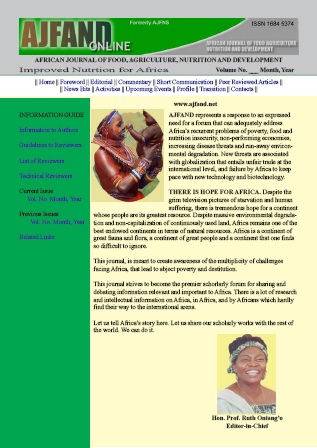
|
African Journal of Food, Agriculture, Nutrition and Development
Rural Outreach Program
ISSN: 1684-5358
EISSN: 1684-5358
Vol. 19, No. 1, 2019, pp. 13946-13958
|
 Bioline Code: nd19006
Bioline Code: nd19006
Full paper language: English
Document type: Research Article
Document available free of charge
|
|
|
African Journal of Food, Agriculture, Nutrition and Development, Vol. 19, No. 1, 2019, pp. 13946-13958
| en |
Potential Uses, Perceptions and Policy Issues of Genetically Modified Crops in Africa: A Case Study of Kenya
Kosgey, Zennah & Cyrus, Kimani
Abstract
Various genetic engineering techniques have been applied to develop genetically
modified (GM) crops. These techniques have the greatest potential to address food
insecurity and malnutrition problems in developing countries, for example, transgenic
techniques have been successful in the development of bio-fortified cassava in Africa.
Some techniques such as RNA interference (RNAi), virus induced gene silencing
(VIGS) and CRISPR-Cas9 genome editing could also be of great use in developing
disease and pest resistant or locally adapted cultivars. The GM crop adoption in Kenya
has been hindered by lack of strong legislation structures, lack of knowledge about GM
technology among the public and external influences. There is also lack of
understanding about what GM crop development entails. There has been some progress
in putting in place policies that build institutional capacity and regulate the use and
handling of GM crops. These include the National Biotechnology Policy, the Biosafety
Act of 2009, and the establishment of the National Biosafety Authority. Although
Kenya has made some progress in putting in place legislations, the country is still far
from incorporating the GM crops into the food system.
Keywords
GM crops; Genetic engineering techniques; GM crop perceptions; Policy issues; Food security
|
| |
© Copyright 2019 - African Journal of Food, Agriculture, Nutrition and Development
Alternative site location: http://www.ajfand.net/
|
|
